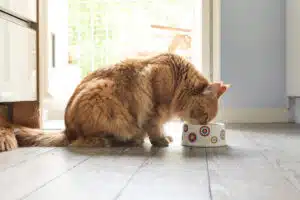Depending on the underlying health problems of your cat, your cat may be dehydrated. In these cases, you may need to consider dehydration treatments for your cat.
Signs of dehydration in cats
Symptoms of dehydration in cats can be hard to recognize, but there are some signs you can look for to identify if your cat is at risk. If you’re concerned, a trip to the vet is the best way to make sure that your pet receives the help it needs.
Skin turgor is an easy way to tell if your cat is dehydrated. If you lift your cat’s skin over its shoulder blades, it should snap back into place with a little bit of effort. If it doesn’t, your cat is probably dehydrated.
Other signs of dehydration in cats include sunken eyes, dry gums, and dry stool. In severe cases, your cat may also seem lethargy or weak. You may also notice that your cat isn’t eating or drinking as much as it normally does. These signs should be treated promptly to avoid serious complications.
Cats aren’t usually prone to dehydration, but it’s a good idea to check on your cat’s water intake regularly. Cats should drink at least four ounces of water for every five pounds of body weight. They should also have access to at least two different water sources. Try moving your cat’s water bowl away from the litter box.
Another test for determining if your cat is dehydrated is the skin pinch test. If your cat has elastic skin, this is a great way to tell if it’s getting the water it needs.
Treatment for dehydration in cats with underlying health issues
Getting your cat the right treatment for dehydration is critical. This can prevent serious complications from occurring. Your cat may experience symptoms such as diarrhea, dry gums, and loose stools.
In order to treat dehydration in your cat, your veterinarian will need to perform a physical examination and complete blood work. He will then determine whether your cat’s kidneys are working properly. If they are, your vet may prescribe medications to treat the problem. Alternatively, your veterinarian may recommend intravenous fluid therapy. These fluids are sterile electrolyte water solutions that are administered through a needle. They are then slowly absorbed into the bloodstream.
Dehydration can be caused by a number of factors, including trauma, heatstroke, and kidney disease. If you think your cat is experiencing dehydration, you should take him to the vet as soon as possible.
During the examination, your veterinarian will ask you about your cat’s eating habits and drinking habits. He will also examine your cat’s skin for turgor. A cat with severe dehydration will have tenting. The skin may also be a pale color.
If your cat is experiencing dehydration, your veterinarian may administer intravenous fluid therapy. In this procedure, an IV is inserted into the vein and fluid is slowly absorbed into the bloodstream.
Your cat may also need subcutaneous fluid therapy. This treatment consists of a needle attached to a fluid bag placed under the skin. This treatment will slowly hydrate the cat’s tissues.
Prevention of dehydration in cats with underlying health issues
Depending on the condition of the cat, dehydration can be treated by a variety of methods. However, it is important to identify the underlying health issue before beginning treatment. This will help to prevent more serious problems later on.
Typical symptoms of dehydration in cats include a slow rate of urination, difficulty passing stool, and changes in appetite and heart rate. If you notice these signs, you should contact your veterinarian for further evaluation.
A veterinarian can determine the cause of dehydration by performing a series of tests. These tests may include blood and urine samples. They can also assess the fluid level in the body using a packed cell volume test or a total blood protein test.
If your cat is dehydrated, your veterinarian may recommend subcutaneous fluid therapy. During this procedure, fluids are injected directly under the skin. The procedure can be performed on a regular basis to maintain a cat’s fluid level or to treat severe dehydration. The fluids will usually rehydrate the cat within a few hours or days.
In more severe cases, a veterinarian may recommend intravenous fluid therapy. A catheter can be placed into the cat’s vein to direct fluids directly into the bloodstream.
Some cats prefer to drink from a running faucet or fountain. However, it is important to provide the cat with a steady source of clean drinking water.














